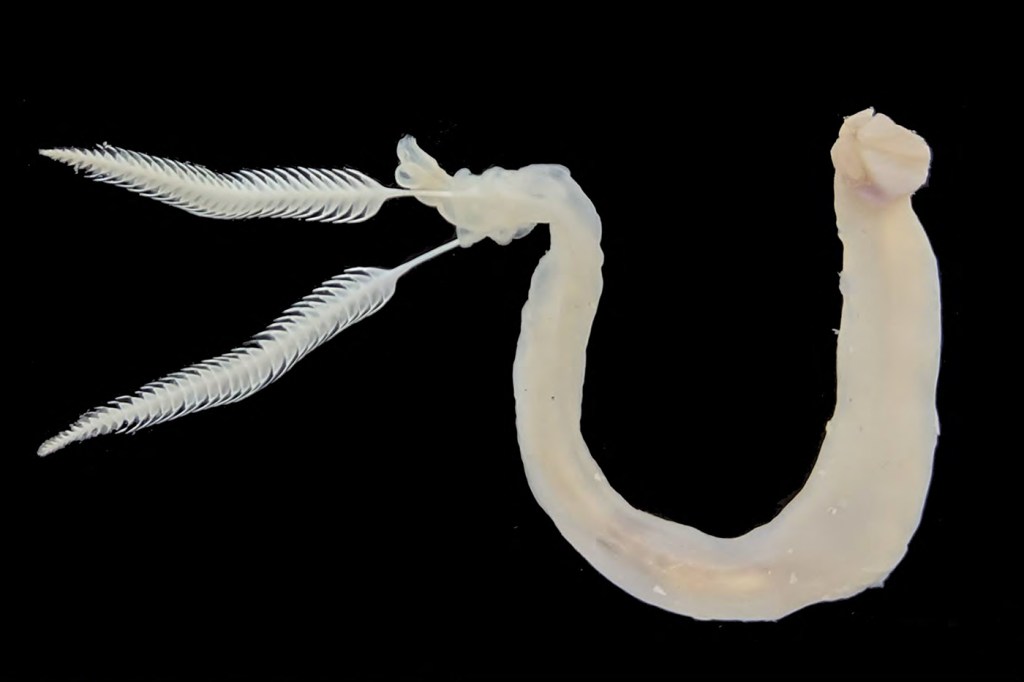Shipworms can chew through a boat. Northeastern researchers explain their digestive process

Known as the clam that has sunk a thousand ships, shipworms are strange looking—and strange acting—animals.
A wormlike clam that can grow at least as long as two meters, the shipworm feasts on wood by burrowing its shell-encased head into the hulls of ships and other marine woods and grinding the cellulose into particles with tiny shell teeth.
But unlike termites—which have bacteria in their gut to break down the wood they consume—the bacteria that shipworms need to produce digestive enzymes are at the other ends of their bodies, in the gills.
In 1848, French scientist Gerard-Paul Deshayes described extremely tiny ducts running the length of the shipworm from the gills to the bivalve’s mouth and stomach, but could not explain what they were for.
Using the latest technological tools that sectioned the shipworm into microscopic slices, scientists at Northeastern’s Marine Science Center and Coastal Sustainability Institute in Nahant, Massachusetts, have solved the mystery.
In a paper published Nov. 9 in Proceedings of the Royal Society B—the flagship of the Royal Society’s biological research journal—research professor Dan Distel and his research assistant, Marvin Altamia, explained how wood-dissolving enzymes make their way through the shipworm’s body via the ducts that are only the fraction of the diameter of a human hair.

“There has always been this question of how these enzymes get from the gill to some place where they can actually help the animal digest wood,” says Distel, director of Northeastern’s Ocean Genome Legacy Center. “There’s this physical transport from one location to another. That’s what we solved in this paper.”
His lab drew on Distel’s post-doctoral work with John Waterbury at the Woods Hole Oceanographic Institution in which Distel used fluorescent DNA markers—then one of the latest technologies in molecular biology—to demonstrate bacteria Waterbury had grown in the lab was the same organism that invades shipworm cells.
It was one of the very first uses of fluorescent in situ hybridization, or FISH, Distel says.
The fact that shipworms have bacteria that help them function is of interest to scientists.
“For vertebrates, like us, if you have bacteria inside your cells, you are very sick. Invertebrates can have bacterial infections inside their cells that are actually beneficial,” called symbionts, Distel says.
For this latest round of research, his lab took tiny shipworms of one to two centimeters and sliced them thinly with a guillotine-like device called a microtome.
Shipworms are like tubes, with the head tunneling into wood and the gills at the other end where they absorb oxygen from seawater.
Distel and his researchers created lab-grown antibodies shipworm-produced enzymes synthesized from genetic sequences. They then applied the antibodies to the shipworm slices to see where they stuck.
A second fluorescent antibody was then applied to light up and visualize the enzymes under microscopic examination, providing a roadmap of the travel route of the digestive enzymes that turned out to be exactly as Deshayes had described, Distel says.
“We could see staining in the gills where bacteria are, we can see staining in the gut and we can follow the duct from the gills back to the stomach and mouth. We were able to connect the dots,” he says.
The ducts in question are very tiny—about 30 to 50 microns in diameter. A human hair is about 90 microns across.
“But apparently, (the ducts) are big enough to act as a little fire hose, to carry the enzymes” to the mouth and gut, Distel says.
Next, he would like to explore how the enzymes created by the bacteria within the host cells of the shipworm cross the cell membrane to travel to the ducts so that they can then be transported to the digestive tract.
In many ways, “the shipworm is kind of a tiny, natural model for a big cellulosic ethanol plant,” Distel says.
Understanding how it functions can aid in the production of renewable liquid fuel from agricultural and paper waste, he says.
Scientists are also interested in understanding how symbiotic or beneficial bacteria avoid sickening animals whose cells they inhabit,” Distel says.
“From that, can you learn something about how to treat pathogenic infections?”
As for shipworms themselves, mysteries remain. Distel says no one knows how long they can live, but scientists know they become fertile within a month or two of being born.
“Then they continue to grow and grow and grow,” Distel says, adding that shipworms can eat through the hull of a wooden ship in a few months.
Shipworms even eat ancient cypress wood from an underwater forest uncovered by hurricanes eight miles off the coast of Alabama. The forest is featured in a video produced by the Marine Science Center and released in October.
“They have something that we call indeterminate growth,” Distel says. “Which means they just continue to grow as long as there is wood to eat. Or something kills them.”
For media inquiries, please contact media@northeastern.edu.






